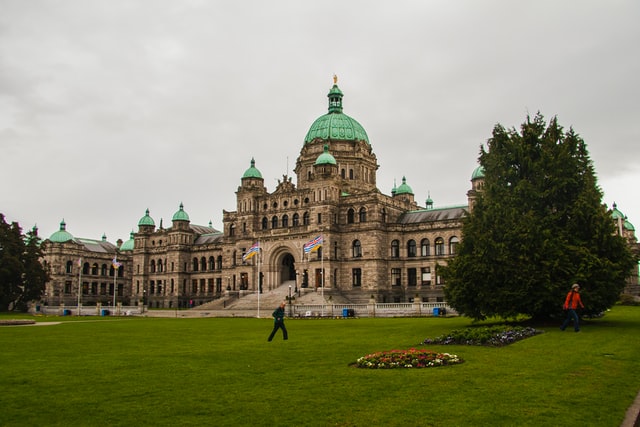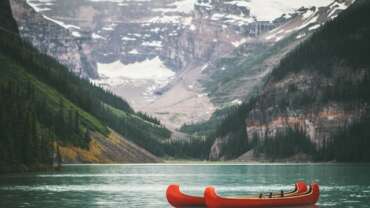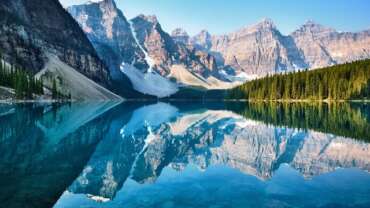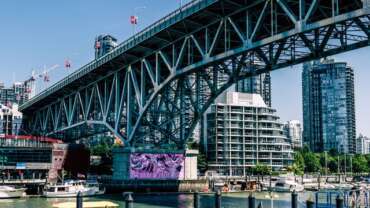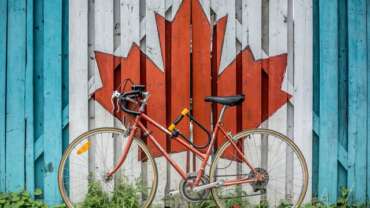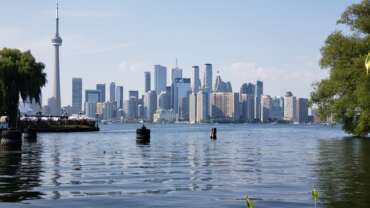Attractions in Canada
Niagara Falls
Niagara Falls is Canada’s most famous natural attraction, bringing in millions of visitors each year. Located just over an hour’s drive from Toronto, along the American border, these massive falls drop approximately 57 meters. You can see the falls at an astoundingly close distance from several key points.
Niagara Falls and the Niagara Gorge have been attracting tourists and daredevils for well over a century. Between the mid-19th and mid-20th centuries there were numerous attempts to plunge over the falls in various types of homemade boats and barrels. This, along with tightrope walkers and other spectacles, led to the adjacent town of Niagara Falls developing a carnival type atmosphere that still persists today. Families will enjoy a walk down Niagara’s outrageous Clifton Hill leading to the gorge and falls.
Banff National Park & the Rocky Mountains
Banff National Park lies in the heart of the majestic Rocky Mountains in the province of Alberta, and showcases some of Canada’s most beautiful scenery. Turquoise-colored lakes, snow-capped peaks, and glaciers are all easily accessible in this stunning park.
The jewel of the park is Lake Louise, where green waters reflect the surrounding mountains and glaciers, and visitors can stroll easily around the shores. Just a short distance is Moraine Lake, another impressive alpine lake with an even slightly more dramatic surrounding.
The Icefields Parkway, which runs from Lake Louise to Jasper, is an unforgettable drive and another major attraction in Banff. At the south end of the park is the lovely little town of Banff, providing all kinds of options for accommodation, shopping, dining, and nightlife.
Banff is also a major winter sports area and home to Lake Louise Ski Resort and Sunshine Village, two of Canada’s most prominent ski destinations.
Toronto’s CN Tower
On the shores of Lake Ontario in Canada’s biggest city is the iconic CN Tower, one of Canada’s most famous landmarks. The tower stands an impressive 553 meters high and dominates the skyline.
At the top, you can find fine dining in the revolving 360 restaurant, and enjoy a meal while looking out over the city and lake. The LookOut and the Glass Floor offer beautiful views out over the entire area. But even those who choose not to go up the tower will find themselves stopping to stare at the structure, which is visible from almost everywhere in the city. At night, the tower is lit in different colors.
Old Quebec (Vieux-Quebec)
Old Quebec is a UNESCO World Heritage Site and one of Canada’s historic gems. Spread across the Upper and Lower Town of Quebec, this area contains the city’s most historic buildings. The Lower Town, along the St. Lawrence River, is the site of the original settlement and home to the outstanding Fairmont Le Château Frontenac, as well as numerous other treasures. The Upper Town rests on 100-meter-high cliffs and is home to the Citadel, the Plains of Abraham, Place d’Armes, and the Parque Historique de l’Artillerie.
Old Quebec is one of Canada’s most popular historical areas and is well developed for tourism. In addition to the historical sites, other highlights include artists displaying their works on Rue du Trésor; interesting museums, like the Musée de la Civilisation; and unique shops and restaurants.
Whistler
Just a two-hour drive from Vancouver is the famous ski resort and village of Whistler. While Whistler has always been an important winter sports area, it has also developed into a popular summer destination, with golf, mountain biking, and a lively town atmosphere throughout the year.
The village gained international attention in 2010 when it became one of the locations for the 2010 Winter Olympic Games. The area offers world class skiing, hotels, and dining, as well as a variety of outdoor recreational opportunities and beautiful mountain scenery.
Ottawa’s Parliament Hill
Ottawa’s Parliament Hill stands high above the Ottawa River and is graced by the Neo-Gothic-style Parliament buildings built in the last half of the 19th century. The most prominent feature is the Peace Tower, which divides the House of Commons and the Senate on either side. In front of the Parliament buildings is the Centennial Flame, lit in 1966 to commemorate the centenary of the Canadian Confederation, and behind the buildings is a sculpture garden.
In the summer, the Changing of the Guard takes place on the front lawn of the Houses of Parliament, weather permitting. Below Parliament Hill, a lovely walk runs alongside the Ottawa River.
St. John’s Signal Hill National Historic Site
At the entrance to St. John’s harbor, overlooking the city and sea, is Signal Hill National Historic Site. It was here, in 1901, that the first wireless transatlantic signal was received. It also played a strategic role in the Seven Years war with France, although the current fortifications were built during the hostilities of 1812.
The Cabot Tower is one of the key sites of Signal Hill. It was built in 1897 to mark the four hundredth anniversary of the discovery of Newfoundland. It also now commemorates Guglielmo Marconi’s reception here in 1901 of the first transatlantic radio telegraphy signal, transmitted over a distance of 2,700 kilometers from Poldhu in England. In the tower are exhibitions on the history of Signal Hill and the history of communications (with a special section on Marconi). From the top, you can enjoy panoramic views of the city and the coast as far as Cape Spear — the most easterly point of North America.
Old Montreal
Old Montreal, lined with lovely historic buildings, is a place to go for great shopping and fine dining. While Montreal itself is a vibrant modern city, Old Montreal, down by the waterfront, is where most tourists come to soak up the atmosphere. Some of the must-see places in Old Montreal include Rue Bonsecours and the landmark Marché Bonsecours in the old town hall building, the interior of the beautiful Notre-Dame Basilica, the lively Place Jacques-Cartier, and the 1870s City Hall.
Polar Bears of Churchill, Manitoba
One of Canada’s most unique attractions is the polar bear migration that sees these beautiful creatures make their way from land out onto the ice in Hudson Bay, near the town of Churchill in Northern Manitoba.
This small community opens itself up to tourists each fall. Tours take visitors out in tundra buggies with caged windows for close encounters with the polar bears. The prime viewing time occurs in October or November while the bears are waiting for the water to freeze before heading out onto the ice.
Vancouver Island
Although it is less than a two-hour ferry ride from the mainland, Vancouver Island can seem a world away. Most people head to Victoria, BC’s capital city, for sightseeing and culture, but if you head north into the wild and remote landscapes, the island holds some unexpected and unforgettable experiences. Nature lovers can hit the best hiking trails on Vancouver Island and set themselves up at some beautiful camping locations. Those looking for more comfort can always turn to one of the island’s lodges or resorts.
On the rugged west coast, a magnificent scene of huge ancient trees, sandy coves, and dramatic rocky shores reveals itself as you drive up to Tofino. Around this tiny but incredibly popular off-the-beaten-path tourist town, in nearby Pacific Rim National Park Reserve, you can find incredible hiking trails, endless beaches, great surfing spots, camping, and places where you can simply soak up nature in peace.
Tofino is a year-round destination, although in the storm season from November to March, many visitors come to appreciate the huge waves rolling ashore; some come to surf, and others come simply to cozy up next to a fire in one of Tofino’s lovely resorts looking out over the Pacific Ocean.
Other destinations around the Island, include Nanaimo, Parksville, and Qualicum Beach, all on the eastern shore, looking out onto the Salish Sea. If you really want to get away from it all, head up to the far north of the island and explore Cape Scott Provincial Park.
Bay of Fundy
The Bay of Fundy, located in Eastern Canada in between New Brunswick and Nova Scotia, is known for its amazing tides. The variation between high and low is the largest in the world, measuring up to a maximum of 19 meters (10 fathoms). While there are many ways to appreciate this natural wonder, some of the most popular locations and sights along the Bay of Fundy are the cliffs and rock formations at Hopewell Cape, Fundy National Park, the Fundy Trail Parkway, and Grand Manan Island.
Victoria’s Inner Harbour
Few Canadian cities have done such a beautiful job of developing their waterfront area as Victoria and its Inner Harbour. This is a great place for strolling, relaxing, shopping, dining, and watching street performers all against the backdrop of the harbor.
The centerpiece of this area is the historic Empress Hotel, one of the city’s most lovely buildings. Over the years, the Empress has welcomed kings and queens and, today, features a traditional high tea, which is one of the highlights for many visitors coming to Victoria. While the harbor area is popular year-round, it is particularly lively during the summer months.
Gros Morne National Park
Newfoundland’s Gros Morne National Park is more remote than many of Canada’s most popular national parks, but worth the effort to discover this beautiful landscape of mountains and fjords. The park is a UNESCO World Heritage Site featuring steep cliff walls, waterfalls, and interesting rock formations carved by the glacier-fed waters.
Most visitors take a boat tour to appreciate the scenery, but there are also hiking trails and opportunities for kayaking. In winter, the park receives far fewer visitors, but is open for ski touring, complete with backcountry ski huts.
Vancouver’s Stanley Park
One of Vancouver’s greatest treasures is the 405-hectare Stanley Park, conveniently located on the west side of the downtown area. Situated on a peninsula, the park is surrounded by the ocean and home to huge red cedar and Douglas fir trees. The seawall, which rings the park, has an extensive walking, jogging, and biking path with designated lanes for walkers and bikers. From the seawall are some lovely views of the city and mountains. A scenic drive also winds through Stanley Park with numerous pullouts.
Within the park are the Vancouver Aquarium, scenic Beaver Lake, and the Stanley Park Pavilion and Rose Garden. Also of special interest are numerous totem poles, some of which were erected more than 100 years ago.
Calgary Stampede
This 10-day affair is one of the most widely anticipated events in Western Canada, with many locals and summertime travelers planning their holidays around the Calgary Stampede. For this week in July, the city of Calgary turns into a true western town, where people who might otherwise be wearing suits to work instead don jeans and cowboy boots.
At the Stampede Grounds are daily rodeo events drawing participants from across North America, thrill rides, games, food, and the nightly Grandstand Show. Around town, free “Stampede Breakfasts” are hosted by numerous establishments either at indoor or outdoor locations and usually consist of pancakes. Many big name country music performers also typically come to the city for this event.
Canadian Museum for Human Rights
Winnipeg’s newest major attraction, which has drawn both national and international attention, is the Canadian Museum for Human Rights. Opening in 2014 near The Forks, the building displays a unique design that is eye-catching to say the least, with geometry and colors based on images of the Canadian landscape.
Also unique is the concept behind the museum, which proved controversial when deciding which histories would be featured here. The museum highlights personal stories, capturing different perspectives, and focuses on a range of themes.



